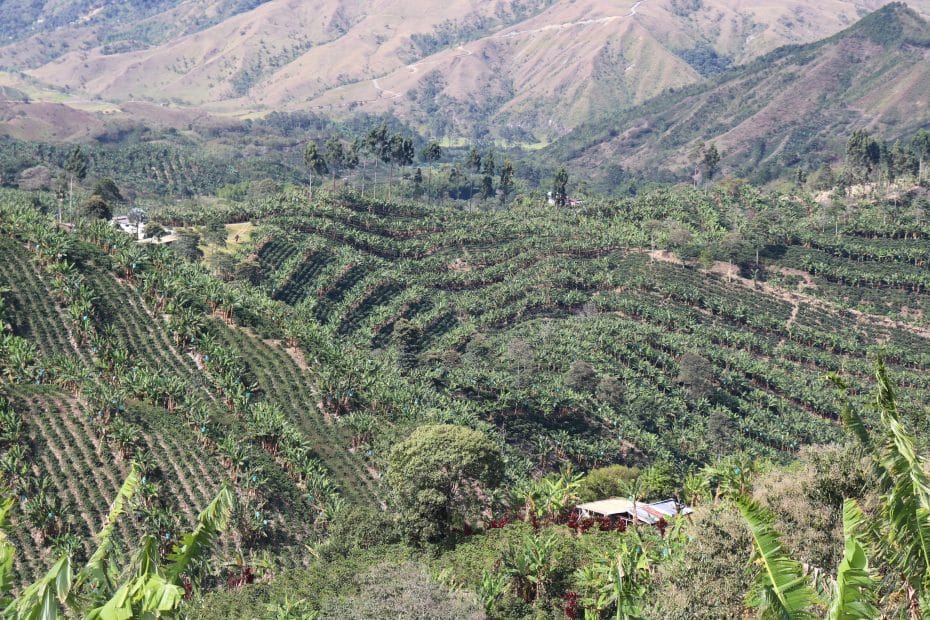Today, Colombia is the third-biggest coffee producing country in the world, behind only Brazil and Vietnam. Ask anybody that you meet where coffee grows, and the chances are that it’ll be one of the first countries they mention.
While coffee grows in dozens of countries all across the Bean Belt, a number of important campaigns – including the development of the Juan Valdez character – have helped promote the interests of Colombian coffee growers for decades.
To learn more about the history of Colombian coffee and how it has evolved, I spoke to two industry experts. Read on to find out what they said.
A Brief History Of Colombian Coffee
Although Brazil and Vietnam rank first and second for global coffee production, Colombia is the third-largest coffee producer in the world, and second in terms of global arabica production.
At the end of 2019, the Federación Nacional de Cafeteros (FNC) reported that Colombia was the world’s largest producer of mild washed arabica coffees. It’s no exaggeration to say that the country has become recognised for arabica production – even though the plant has only grown in Colombia since the 18th century.
There are a number of theories as to how the Coffea arabica plant first arrived in Colombia. The most widely accepted is that it was brought over by Dutch Jesuit missionaries in the 18th century, who planted the first crops in the mountainous northeast. From there, it spread throughout the country, as smallholder family farms increasingly adopted it as a new source of income.
However, it wasn’t until the early 1800s that the country began exporting coffee on a commercial scale. Despite this, by the end of the 19th century, Colombia had become one of the biggest coffee exporters in the world.
Colombian Climate Conditions
As we know, arabica is considerably more difficult to grow than robusta. The species is incredibly climate sensitive, and requires high altitude and a steady temperature range that never gets too hot or cold.
Alejandro Cadena is the co-founder and CEO of Caravela Coffee. He says that part of the reason that Colombia has become synonymous with significant arabica production is because it naturally provides optimal conditions for cultivating the arabica plant..
“The combination of ecosystems, altitude, and climate in Colombia means that there is a wide array of microclimates,” he says.
“Alongside very good farm practices, [these allow] the country to consistently produce arabica coffee all year round.”
A Focus On Good Farm Practices
However, favourable climate conditions alone aren’t enough: specific farming practices are key to the successful production of high-quality arabica coffee.
When growing specialty coffee, producers all around the world have an extensive range of processes and variables to consider, from harvesting and drying methods through to meticulous soil management and plant pruning.
To understand why Colombia excels in these areas, I spoke with the CEO of Colombia’s Federación Nacional de Cafeteros, Roberto Velez. He told me that the country has been investing in coffee production for a while.
“Through a combination of research and development and technical assistance, coffee growers are constantly made aware of the importance of following the best production practices,” he says.
“These include using rust-resistant varieties, planting at the right moment, increasing densities, and keeping young crops to increase productivity, quality and income.”
Alejandro agrees with Roberto, highlighting the major impact that investment has had on boosting Colombia’s profile in the coffee industry.
“Not only have we seen investment in marketing, but also in scientific research and technical assistance, as well as both public and private infrastructure,” he says.
“This combination of climate and institutional investment is what has really influenced Colombia’s reputation as a high-quality origin for well over 50 years, both in the minds of roasters and consumers.”
La Federación Nacional de Cafeteros
Around the beginning of the 20th century, the majority of coffee production in Colombia was in the hands of a few major producers who operated major farms, also known as haciendas. The workers on these haciendas were made up of peasants, the indigenous populace, and former slaves.
In 1927, a group of prominent coffee producers from the Zona Cafetera region got together and formed the Federación Nacional de Cafeteros de Colombia (FNC). Their objective was to represent the farmers in promoting and negotiating fair prices for the global sale of their coffee.
However, as the impact of the Great Depression spread throughout the late 1920s and 1930s, the global price of coffee plummeted, causing many of the Colombian haciendas to go bankrupt.
In an attempt to save the coffee production and tackle price volatility, the government purchased these big farms, divided them up, and sold them to workers who could plant other crops alongside coffee.
Since then, the FNC has largely continued its efforts on behalf of Colombian coffee producers to leverage the country’s image as a coffee origin on the global stage. One such example came in 1961 when the organisation created the “100% Colombian coffee” seal.
Alejandro tells me that with this new seal, leveraged as a marketing tool, producers were able to “decommoditise and differentiate Colombian coffee in the [global] marketplace”.
This was one of the first ingredient branding exercises in the world – across all sectors, not just coffee – and meant that consumers were able to easily identify Colombian coffee on supermarket shelves.
“It also helped push up the premium price of Colombian coffee that we see today,” Alejandro adds.
Who Is Juan Valdez?
Beyond the “100% Colombian coffee” seal, a large part of Colombian coffee’s success on the global stage can arguably be attributed to the Juan Valdez campaign.
First “launched” in the US in 1958, Juan Valdez is a fictional coffee farmer who first appeared in adverts for the FNC alongside his mule, Conchita. This was another part of the FNC’s efforts to distinguish Colombia from other origins on the global stage..
“The campaign helped place Colombian coffee in the minds of coffee drinkers the world over,” Alejandro says. “It also helped highlight the work involved in producing the coffee by showing videos of the coffee farms at work.”
The campaign was so successful that it soon became associated not just with Colombian coffee, but also with the country itself.
“The image of Juan Valdez not only created a coffee brand, but it also defined a nation. It was so popular and successful among US consumers,” Alejando says.
According to a documentary on the Juan Valdez phenomenon, the image of the coffee farmer and his mule represents respect, tenacity, compromise, and good quality produce.
After almost 45 years, the Juan Valdez brand had become so well-recognised that the FNC used it to launch a café chain. In 2002, the organisation opened the first official Juan Valdez cafe; some 18 years on, the chain now has more than 320 locations worldwide.
Colombian Coffee Today
But even though that might summarise how Colombia got to where it is today, what is the perception of Colombian coffee in today’s global market?
Alejandro says: “Colombian coffee is recognised by the coffee industry as a product that is easy to sell thanks to the familiarity and premium qualities it conveys to consumers.
“For coffee roasters, it is an origin with above average quality, which is readily available throughout the year.”
Roberto holds a similar perspective: “Colombian coffee has earned its worldwide reputation on its own,” he says. “When asked about what they value the most, traders and importers highlight its quality and consistency, which is derived from our high-quality export standards.”
Successful specialty coffee production requires that a number of key factors work together, from the right climate conditions and farming methods to research, technical assistance, and involvement from the public sector. Throughout the 20th and 21st century, Colombia has had all of these in no short supply.
But arguably, some of Colombia’s success as a global coffee origin over the last 100 years is down to the FNC and their marketing campaigns. And with both Juan Valdez and the “100% Colombian coffee” seal still a fixture of modern coffee marketing, it doesn’t look like things will change any time soon.

